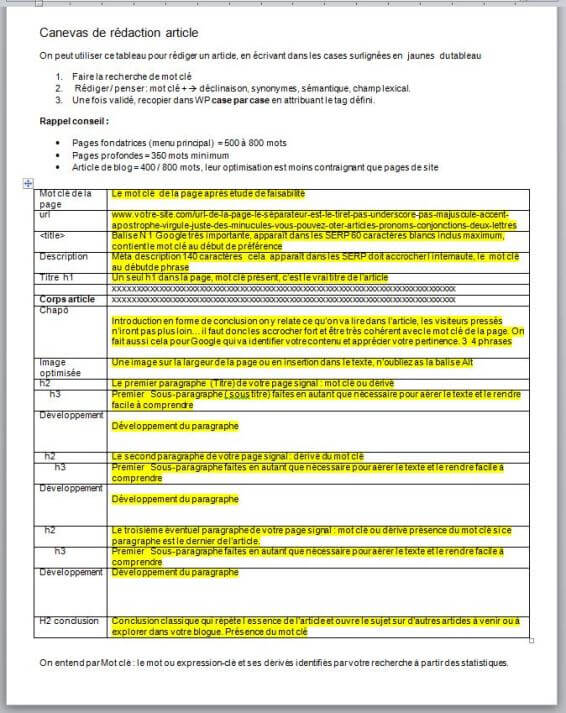Beyond the documentary, entertaining, editorial or literary quality of your content, have you asked yourself the question of structuring your web texts for SEO?
If Google “can read”, it is better to organize his reading, to pre-chew the work.
This text will cover the notions of keyword density, lexical field, paragraph (h tags ), photo, general presentation, and text size.
You should know that the structure of the text matters as much as the content itself if you want your pages to appear in the search results.
This article tries to take stock of this necessary organization of web writing and far from affirming that the model I propose is the only one that works (I don’t have this claim), it will help I hope, people who don’t have an ease for writing to take charge of themselves instead of hiring a web writer…
Web text, key phrases and variants
1) Determining the keyword/phrase on the page will condition the entire structure of the article.
2) This word (its variations) will be present in
- your title> tag < for Google and the snippet,
- your title that will receive the only H1 tag on the page
- URL http://monsite.com/mot-clé-en-contexte/
- And in the hook of the Meta description, for the snippet for the Internet user.
This does not mean that these four elements have to be identical, on the contrary! But they will be close and will be a strong signal to Google and “its colleagues” search engines.
3) The keyword will determine all the vocabulary you will use in the article.
Avoid the heavy and spammy repetition of the keyword itself (see also Matt Cutt’s video if you understand English) and make sure to use the lexical field of the key word.
The lexical field
Definition:
The term “ lexical field ” is defined as vocabulary that relates to the same field, the same reality.
Words that belong to a lexical field do not only have in common that they are synonymous, nouns, adverbs or that they are declined in gender and number.
Above all, they will have the quality of belonging to the same family, to the same field, to the same notion.
For example: the lexical field of “injury” opens up the vocabulary of related fields such as
- doctor, nurse, nursing assistant
- Hospital, operating theatre, infirmary, pharmacy
- blood, wound, fracture, boo-boo
- care, dressing, bandage, disinfection
- pain, sorrow, tears,
- accident, fall, blow
- work stoppage, CSST lawyer, compensatory indemnities
It is without limitation as long as we remain consistent.
We will therefore go in the direction that the article imposes by using this variety of naturally related words…. Words that evoke the “world of injury” and its consequences but which do not belong to its definition and are not necessarily synonyms like lesion, bruise, contusion…
Thanks to this richness of text, Google will assimilate all the paper and position you on the long tail expressions, creating traffic much higher than that of the main targeted query while responding to the user’s search.
Editor’s recommendation
- Write naturally using a simple but rich vocabulary
- Keep the keyword itself for a few specific places in the article. Read more
Structure your text for SEO
Google knows how to read, it associates words by lexical fields, as we have just seen.
It is therefore a question of serving the content to him in such a way that he can understand it and consider it relevant. To do this, you need to make a writing plan… just like at school!
Except that the structuring model is very close to journalistic writing.
- A title (your title which will be tagged H1 will be the only H1 of the page)
- An introduction in the form of a catchy SUMMARY of what is to follow: the chapô
- Indeed, we must immediately know what the article is about: the end, the end and the conclusion in two or three sentences!
- Title of the first paragraph (tagged H2)
- Here we will develop the first idea according to the predetermined writing plan
- Possibly one or more sub-paragraphs (H3) and even sub-sub-paragraphs (H4)
- Title of the second paragraph (tagged H2)
- And so on, as much as necessary
- Conclusion
Then write the content respecting the structure that you have carefully thought out.
During the first draft, be natural in your writing, write simply (subject -verb – complement), use a clear vocabulary, stay as much as possible in the present tense and in the first person singular, air your text with many:
- Page breaks
- line breaks,
- bulleted lists
and insert a nice photo , I like it at the top of the article more or less after the chapô. Don’t forget the Alt tag of the image , still a good place for your keyword
In the conclusion, you summarize once again the essence of the message to be conveyed… without duplicating yourself!
As in “Editorial”, open the conclusion on a related subject, articles with similar topics appearing in your blog.
Keyword density in text
On a 500-word article, if I had to use the key phrase (keyword and close variations) 6 times I would put it once
- in the chapter
- in the first H2 (diluting it) and
- in the last H2 (ditto)
- in the conclusion
- and naturally in the text in a natural way
Summed up in a very simple diagram, it gives
Title (will be tagged h1)
Chapô
A photo ( Tag Alt = “keyword”)
- A) Paragraph (h2)
- (a) Sub-paragraph (h3) (if necessary)
- (b) Sub-paragraph (H3) (Idem)
- B) paragraph (h2)
- C) paragraph (h2)
Conclusion
Structuring a text for SEO is…
Make it accessible to as many people as possible, including search engines, do not search for a density of the keyword, which must be almost natural and not weigh down the reading.
Airing out your text to make it easy and pleasant to read: you must seduce your readers above all…
Organizing the article before writing it allows you to reflect on the strong ideas that will make the paper and helps determine the order in which they will appear. This is a great help when writing. No more blank paper, you fill in a canvas, a guide.
PS 1: Don’t forget to fill in your title and meta description tags.
PS 2: This article follows the outline to the letter.
Before you go, download the SEO writing template
It won’t even cost you your email…
If you think that this little tool can help you write articles that are a little more optimized, download it , it’s a gift.
Thank you for your comments, I love reading and responding to
them Kristof / SEO Montreal

